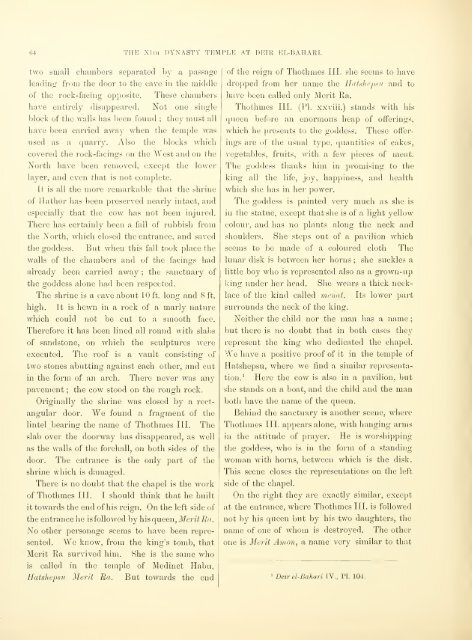The XIth dynasty temple at Deir el-Bahari .. - NYU | Digital Library ...
The XIth dynasty temple at Deir el-Bahari .. - NYU | Digital Library ...
The XIth dynasty temple at Deir el-Bahari .. - NYU | Digital Library ...
You also want an ePaper? Increase the reach of your titles
YUMPU automatically turns print PDFs into web optimized ePapers that Google loves.
64 THE XItii <strong>dynasty</strong> TEMPLE AT DEIR EL-BAHARI.<br />
two small chambers separ<strong>at</strong>ed bv a passage<br />
leading from the door to the cave in the middle<br />
of the rock-facing opposite. <strong>The</strong>se chambers<br />
have entii'<strong>el</strong>y disappeared. Not one single<br />
block of the walls has been found ;<br />
they must all<br />
have been carried away ^vhen tlie <strong>temple</strong> was<br />
used as a quarry. Also the blocks which<br />
covered the rock-facings on the West and on the<br />
North have been removed, except the lower<br />
layer, and even th<strong>at</strong> is not complete.<br />
It is all the more remarkable th<strong>at</strong> the shrine<br />
of ll<strong>at</strong>hor has been preserved nearly intact, and<br />
especially th<strong>at</strong> the cow has not been injured.<br />
<strong>The</strong>re has certainly been a fall of rubbish from<br />
the North, which closed the entrance, and saved<br />
the goddess. But Avhen this fall took place the<br />
walls of the chambers and of the facings had<br />
already been carried away ; the sanctuary of<br />
the goddess alone had been respected.<br />
<strong>The</strong> shrine is a cave about 1 ft. long and 8 ft.<br />
high. It is he"wn in a rock of a marly n<strong>at</strong>ure<br />
which could not be cut to a smooth face.<br />
<strong>The</strong>refore it has been lined all round with slaljs<br />
of sandstone, on which the sculptures were<br />
executed. <strong>The</strong> roof is a vault consisting of<br />
two stones abutting against each other, and cut<br />
in the form of an arch. <strong>The</strong>re never was any<br />
pavement ; the cow stood on the rough rock.<br />
Originally the shrine was closed by a rect-<br />
angular door. We found a fragfment of the<br />
lint<strong>el</strong> bearing the name of Thothmes III. <strong>The</strong><br />
slab over the doorway has disappeared, as w<strong>el</strong>l<br />
as the walls of the forehall, on both sides of the<br />
door. <strong>The</strong> entrance is the only part of the<br />
shi'ine which is damaged.<br />
<strong>The</strong>re is no doubt th<strong>at</strong> the chap<strong>el</strong> is the work<br />
of Thothmes III. I should think th<strong>at</strong> he built<br />
it towards the end of his reign. On the left side of<br />
the entrance he is followed by his queen, Merit En.<br />
No other personage seems to have been repre-<br />
sented. We know, from the king's tomb, th<strong>at</strong><br />
Merit Ra survived him. 8he is the same who<br />
is called in the <strong>temple</strong> of Mediuet Habu,<br />
H<strong>at</strong>shepsu ilerit Ra. But towards the end<br />
of the reign of Thothmes III. she seems to have<br />
dropped from her name the Hoti^hcji.^ii and to<br />
have been called only Merit Ra.<br />
Thothmes III. (PI. xxviii.) stands with his<br />
(jueen befoi-e an enormous heap of offerings,<br />
which he presents to the goddess. <strong>The</strong>se offer-<br />
ings are of the usual type, quantities of cakes,<br />
vegetables, fruits, with a few pieces of me<strong>at</strong>.<br />
<strong>The</strong> goddess thanks him in promising to the<br />
king all the life, joy, happiness, and health<br />
which she has in her power.<br />
<strong>The</strong> goddess is painted very much as she is<br />
in the st<strong>at</strong>ue, except th<strong>at</strong> she is of a light y<strong>el</strong>low<br />
colour, and has no plants along the neck and<br />
shouldei's. She steps out of a pavilion which<br />
seems to be made of a coloured cloth <strong>The</strong><br />
lunar disk is between her horns ; she suckles a<br />
little boy who is represented also as a grown-up<br />
king under her head. She wears a thick neck-<br />
lace of the kind called mennt. Its lower part<br />
surrounds the neck of the king.<br />
Neither the child nor the man has a name<br />
but there is no doubt th<strong>at</strong> in both cases they<br />
represent the king who dedic<strong>at</strong>ed the chap<strong>el</strong>.<br />
We have a positive proof of it in the <strong>temple</strong> of<br />
H<strong>at</strong>shepsu, where we find a similar representa-<br />
tion.^ Here the cow is also in a pavilion, but<br />
she stands on a bo<strong>at</strong>, and the child and the man<br />
both have the name of the queen.<br />
Behind the sanctuary is another scene, where<br />
Thothmes III. appears alone, with hanging arms<br />
in the <strong>at</strong>titude of prayer. He is worshipping<br />
the goddess, who is in the form of a standing<br />
woman with horns, between which is the disk.<br />
This scene closes the represent<strong>at</strong>ions on the left<br />
side of the chap<strong>el</strong>.<br />
On the right they are exactly similar, except<br />
<strong>at</strong> the entrance, where Thothmes III. is followed<br />
not by his queen but by his two daughters, the<br />
name of one of whom is destroyed. <strong>The</strong> other<br />
one is Merit Anton, a name very similar to th<strong>at</strong><br />
<strong>Deir</strong> <strong>el</strong>-<strong>Bahari</strong> IV., PI. 104.<br />
;

















